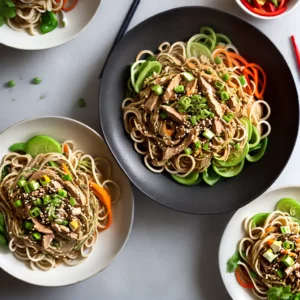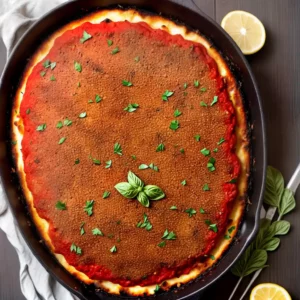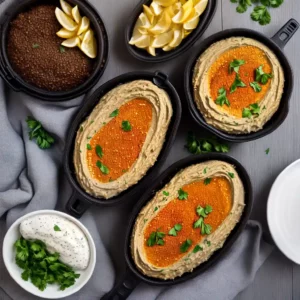How to Freeze Bananas
Learning how to freeze bananas is a simple and convenient way to have them on hand for smoothies, baking, and other recipes.
There are three main methods for freezing bananas: freezing whole or half bananas, freezing sliced bananas, and freezing mashed bananas.
To freeze whole or half bananas, first, slice or halve the bananas and arrange them in a single layer on a baking sheet. Freeze the bananas for about 1 to 2 hours until they’re completely frozen. Then transfer them to a freezer-safe bag labeled with the date and store in the freezer for up to 3 months.
For sliced bananas, slice the bananas into 1/2-inch or 1-inch rounds and arrange them in a single layer on a baking sheet. Freeze for 1 to 2 hours until solid, then transfer to a freezer-safe bag and store in the freezer.
To freeze mashed bananas, mash the bananas in a mixing bowl and divide the mashed bananas into equal portions (such as 1/4 cup or 1/2 cup) in a silicone tray or muffin pan. Freeze for 2 to 3 hours, then transfer the frozen banana blocks to a freezer-safe bag and store in the freezer.
When using frozen bananas in recipes, it’s recommended to thaw them first by letting them thaw overnight in the fridge or at room temperature for about 1 1/2 to 2 hours. Frozen bananas can be used in smoothies, smoothie bowls, ice cream, baking, and more. They’re a convenient ingredient to have on hand for various recipes.
How to Freeze Bananas – Key Takeaways:
- Freezing bananas is a simple and convenient way to have them on hand for future use in smoothies, baking, and other recipes.
- There are three main methods for freezing bananas: freezing whole or half bananas, freezing sliced bananas, and freezing mashed bananas.
- Whole or half bananas can be frozen by slicing or halving them and arranging them in a single layer on a baking sheet before transferring them to a freezer-safe bag.
- Sliced bananas can be frozen by arranging them in a single layer on a baking sheet before transferring them to a freezer-safe bag.
- Mashed bananas can be frozen by dividing them into equal portions and freezing them in a silicone tray or muffin pan before transferring them to a freezer-safe bag.
Why Freeze Bananas?
Freezing bananas allows you to enjoy them later in smoothies, banana bread, and various other recipes. It’s a simple and convenient way to make sure you always have ripe bananas on hand, even if you don’t plan on using them right away. Not only does freezing bananas extend their shelf life, but it also preserves their natural sweetness and creamy texture.
When bananas start to become overripe, their skins turn brown and spotty, making them less appealing to eat as is. Instead of letting them go to waste, freezing them is a great solution. Frozen bananas can be used to make deliciously creamy smoothies, dairy-free ice cream, or even added to baked goods like muffins and pancakes for added flavor and moisture.
To freeze bananas, there are three main methods you can choose from: freezing whole or half bananas, freezing sliced bananas, or freezing mashed bananas. Each method has its own advantages, depending on how you plan to use the frozen bananas in your recipes. Let’s take a closer look at each method.
Freezing Whole or Half Bananas
To freeze whole or half bananas, start by slicing or halving the bananas and arranging them in a single layer on a baking sheet lined with parchment paper. This prevents the bananas from sticking to the sheet and makes it easier to remove them once frozen. Place the baking sheet in the freezer and let the bananas freeze for about 1 to 2 hours, or until they’re completely frozen. Once frozen, transfer the bananas to a freezer-safe bag or container, label it with the date, and store them in the freezer for up to 3 months.
Freezing whole or half bananas is a great option if you plan on using them for smoothies or blending into nice cream. They’re also handy to have on hand when you want to make a quick and healthy snack.
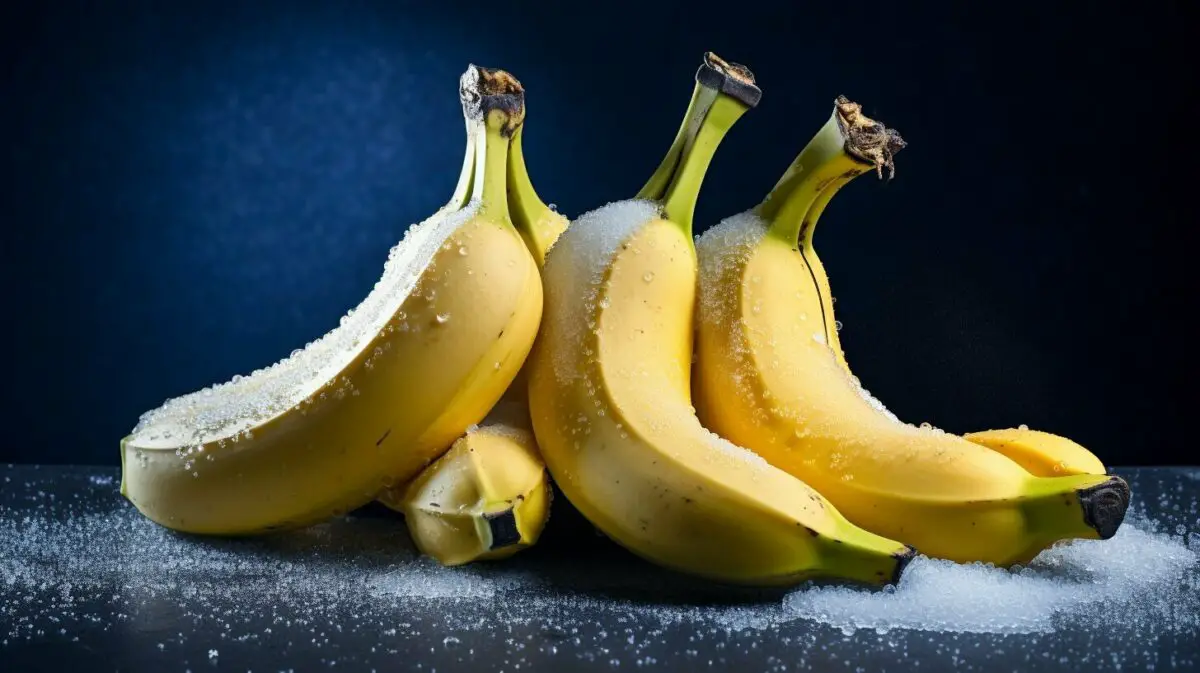
If you prefer to have pre-sliced bananas ready to use, you can freeze them in slices. Simply slice the bananas into 1/2-inch or 1-inch rounds and arrange them in a single layer on a baking sheet lined with parchment paper. Place the baking sheet in the freezer and let the banana slices freeze for about 1 to 2 hours until solid. Once frozen, transfer the slices to a freezer-safe bag or container, label it with the date, and store them in the freezer.
Sliced frozen bananas are perfect for adding to smoothie bowls, blending into creamy milkshakes, or even using as a topping for oatmeal or yogurt.
Freezing Mashed Bananas
If you have ripe bananas that are on the verge of becoming too mushy to eat, freezing them in mashed form is a great option. Mash the bananas in a mixing bowl until smooth and creamy. Divide the mashed bananas into equal portions, such as 1/4 cup or 1/2 cup, and spoon them into a silicone ice cube tray or muffin pan. Place the tray or pan in the freezer and let the mashed bananas freeze for about 2 to 3 hours, or until solid. Once frozen, remove the banana blocks from the tray or pan and transfer them to a freezer-safe bag or container labeled with the date.
When you’re ready to use mashed frozen bananas, simply thaw the desired amount and add them to your recipes. They’re perfect for making banana bread, muffins, pancakes, or even healthy two-ingredient cookies!
Learning how to freeze bananas is a simple and convenient way to have ripe bananas on hand for smoothies, baking, and other recipes. Whether you choose to freeze whole or half bananas, sliced bananas, or mashed bananas, you’ll never have to let overripe bananas go to waste again. Freezing bananas preserves their sweetness and creamy texture, making them a versatile ingredient to have in your freezer at all times.
Choosing the Right Bananas to Freeze
When freezing bananas, it’s best to use ripe or overripe bananas as they will provide the best flavor and texture. Ripe bananas have a yellow peel with small brown speckles, indicating that they are sweet and soft. Overripe bananas have a completely brown peel and are even sweeter and softer, making them ideal for baking and smoothies.
To choose the right bananas for freezing, look for ones that are at the desired level of ripeness. If you plan to use the frozen bananas for baking, it’s recommended to use overripe bananas as they will add a natural sweetness to your recipes. However, if you prefer a milder flavor, ripe bananas can also be used.
One benefit of freezing bananas is that you can prolong their shelf life and prevent them from going to waste. By freezing ripe or overripe bananas, you can have them readily available for smoothies, nice cream, banana bread, and other delicious recipes, even if you don’t have time to use them right away.
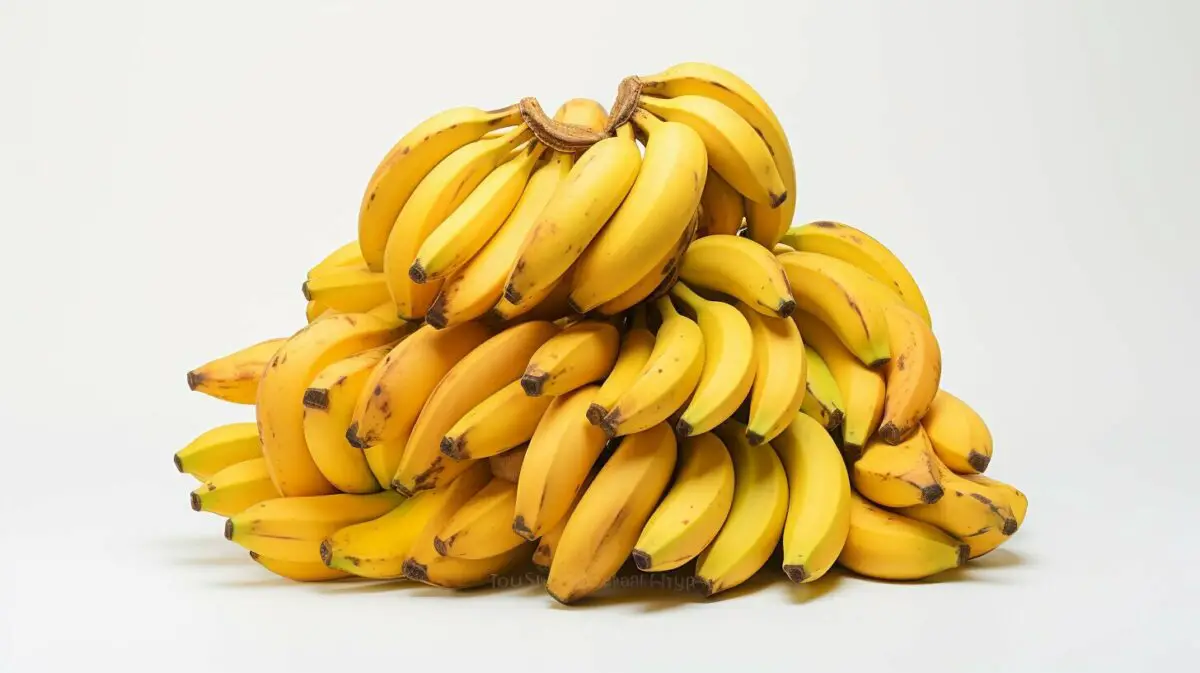
| Benefits of Freezing Bananas | Uses of Frozen Bananas |
|---|---|
|
|
Freezing Whole or Half Bananas
Freezing whole or half bananas is a convenient option for preserving them. Whether you have extra bananas that are ripe and need to be used up or you want to keep a stash of bananas for smoothies and baking, freezing them is a simple way to extend their shelf life. Here’s a step-by-step guide on how to freeze whole or half bananas:
- Start by selecting ripe or slightly overripe bananas. The bananas should have a yellow peel with some brown spots, as this indicates that they are sweet and fully ripened.
- Peel the bananas and slice them into halves or leave them whole, depending on your preference. You can also choose to slice them into smaller pieces for easier blending in smoothies.
- Arrange the sliced or halved bananas in a single layer on a baking sheet lined with parchment paper. Make sure the bananas are not touching each other.
- Place the baking sheet in the freezer and let the bananas freeze for about 1 to 2 hours, or until they are completely frozen.
- Once the bananas are frozen, transfer them to a freezer-safe bag or container. Label the bag with the current date to keep track of their freshness.
- Store the bag or container in the freezer for up to 3 months. Frozen bananas can be kept for longer, but their quality may deteriorate over time.
When you’re ready to use the frozen bananas, simply take out the desired amount and let them thaw. Thawing them in the fridge overnight or at room temperature for a couple of hours should do the trick. Frozen bananas are perfect for making delicious smoothies, adding sweetness to baked goods like banana bread, or even enjoying as a frozen treat on their own.
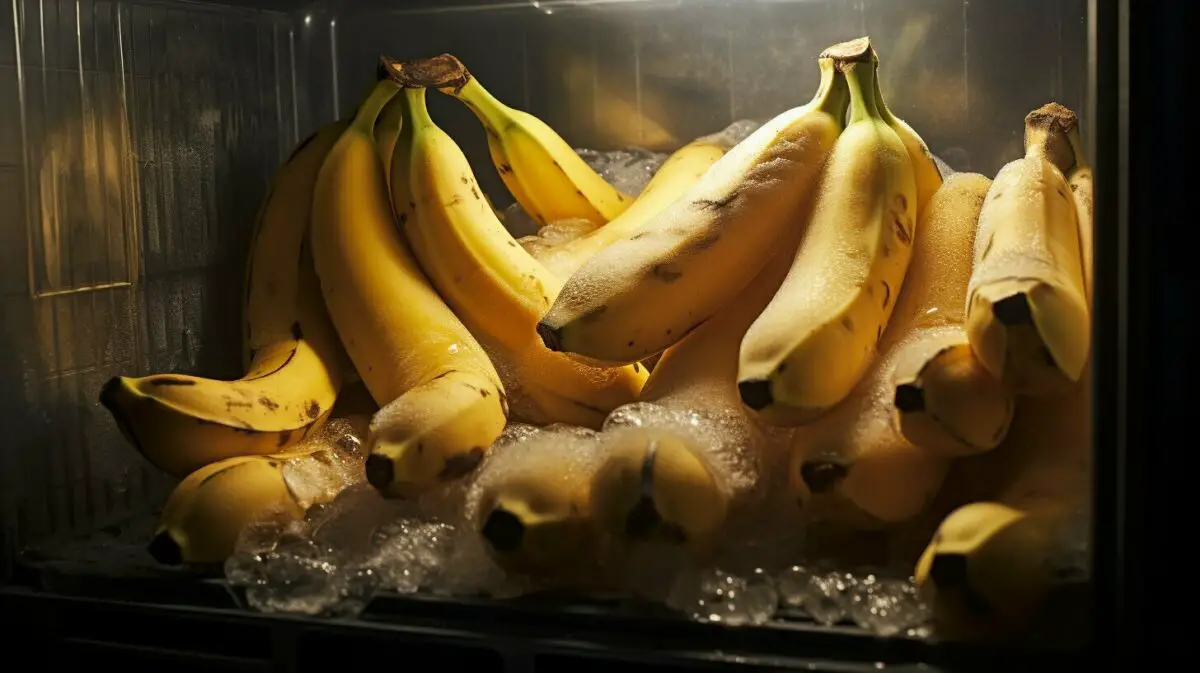
| Step | Instructions |
|---|---|
| 1 | Select ripe or slightly overripe bananas. |
| 2 | Peel and slice the bananas into halves or leave them whole. |
| 3 | Arrange the bananas in a single layer on a baking sheet. |
| 4 | Freeze the bananas for 1 to 2 hours until completely frozen. |
| 5 | Transfer the frozen bananas to a freezer-safe bag or container. |
| 6 | Store in the freezer for up to 3 months. |
Slicing Bananas for Freezing
Slicing bananas before freezing them allows for easier portioning and use in recipes. Whether you want to add them to smoothies, make banana bread, or create delicious frozen treats, having pre-sliced bananas on hand can save you time and effort.
To slice bananas for freezing, start by peeling the bananas and placing them on a cutting board. Use a sharp knife to cut the bananas into uniform slices, about 1/2-inch or 1-inch thick. Alternatively, you can slice them into rounds or chunks, depending on your preference and the recipes you plan to make.
Once the bananas are sliced, arrange them in a single layer on a baking sheet lined with parchment paper or a silicone mat. This will prevent the slices from sticking together during freezing. Place the baking sheet in the freezer and let the banana slices freeze solid, usually for about 1 to 2 hours.
After the banana slices are completely frozen, transfer them to a freezer-safe bag or container. Label the bag with the date and store it in the freezer for up to 3 months. By freezing bananas in slices, you can easily measure out the amount needed for your recipes and avoid wasting any excess fruit.
| Slicing Bananas for Freezing |
|---|
| Peel the bananas and place them on a cutting board. |
| Use a sharp knife to slice the bananas into uniform slices or chunks. |
| Arrange the banana slices in a single layer on a baking sheet lined with parchment paper or a silicone mat. |
| Freeze the banana slices for about 1 to 2 hours until solid. |
| Transfer the frozen banana slices to a freezer-safe bag or container labeled with the date. |
| Store the bag or container in the freezer for up to 3 months. |
With frozen banana slices readily available, you can enjoy the natural sweetness and creamy texture of bananas in your favorite recipes all year round. From smoothies to baked goods, frozen sliced bananas are a versatile ingredient that adds flavor and nutritional value to your dishes.

Freezing sliced bananas is a simple way to always have this nutritious fruit on hand. Whether you’re making a refreshing smoothie or a delicious banana bread, having pre-sliced bananas readily available in the freezer makes preparation a breeze. Plus, frozen banana slices provide a natural sweetness and creamy texture that can elevate your recipes to the next level.
So why wait? Take advantage of the convenience and versatility of frozen banana slices by following these simple steps. Slice, freeze, and enjoy the benefits of having perfectly portioned bananas at your fingertips.
Freezing Mashed Bananas
Mashed bananas can be frozen in convenient portions for quick use in various dishes. Whether you have leftover ripe bananas or want to stock up for future recipes, freezing mashed bananas is an excellent way to minimize waste and have a versatile ingredient readily available. Here’s a simple guide on how to freeze mashed bananas:
- Mash ripe bananas in a mixing bowl until smooth and creamy.
- Divide the mashed bananas into equal portions using a silicone tray or muffin pan. This step makes it easy to thaw the desired amount later.
- Place the tray or pan in the freezer and freeze for 2 to 3 hours until the mashed bananas are solid.
- Remove the frozen banana blocks from the tray or pan and transfer them to a freezer-safe bag.
- Label the bag with the date and store it in the freezer for up to 3 months.
When you’re ready to use the frozen mashed bananas, simply take out the desired portion and thaw it. Frozen mashed bananas are perfect for adding moisture and sweetness to baked goods like banana bread, muffins, and cakes. They also work well in smoothies, pancakes, and even as a base for homemade banana ice cream. With frozen mashed bananas at your disposal, you can enjoy the taste of ripe bananas all year round!

“Freezing mashed bananas allows you to preserve their natural sweetness and flavor, making them a convenient ingredient for a wide range of recipes.”
By freezing mashed bananas, you’re able to preserve their natural sweetness and flavor. This is particularly beneficial if you have overripe bananas that you don’t want to waste. Freezing them in mashed form ensures that you can enjoy their delicious taste in various dishes without compromising their quality.
| Benefits of Freezing Mashed Bananas |
|---|
| Preserves natural sweetness and flavor |
| Reduces food waste |
| Convenient for quick use in recipes |
Additionally, freezing mashed bananas helps to reduce food waste. Instead of letting those overly ripe bananas go to waste, you can transform them into a versatile ingredient that can be used in a variety of recipes. This not only saves money but also promotes sustainability by minimizing unnecessary food waste.
Finally, having frozen mashed bananas on hand offers convenience. You can easily thaw and incorporate them into recipes whenever needed, whether it’s for a delicious smoothie, a delectable baked treat, or a refreshing homemade banana ice cream. With the ability to quickly thaw and use mashed bananas, you can enhance your culinary creations in a hassle-free way.
So, the next time you find yourself with ripe bananas that won’t be eaten in time, consider freezing them in mashed form. By doing so, you’ll have a versatile ingredient ready to elevate your recipes and reduce food waste.
Freezing Bananas – Step-by-Step Guide
Follow these simple steps to freeze bananas properly and preserve their quality. Freezing bananas is a great way to ensure you always have this versatile fruit on hand for smoothies, baking, and other recipes. There are three main methods for freezing bananas: freezing whole or half bananas, freezing sliced bananas, and freezing mashed bananas.
Freezing Whole or Half Bananas
To freeze whole or half bananas, start by slicing or halving the bananas. Arrange them in a single layer on a baking sheet lined with parchment paper or a silicone mat. This will prevent the bananas from sticking to the tray. Place the tray in the freezer and freeze the bananas for about 1 to 2 hours until they’re completely frozen.

| Steps: | Time |
|---|---|
| Slice or halve the bananas | |
| Arrange them in a single layer on a baking sheet | |
| Freeze for about 1 to 2 hours | |
| Transfer to a freezer-safe bag and store in the freezer | Up to 3 months |
Freezing Sliced Bananas
If you prefer to freeze sliced bananas, start by slicing the bananas into 1/2-inch or 1-inch rounds. Arrange the slices in a single layer on a baking sheet lined with parchment paper or a silicone mat. Freeze the slices for 1 to 2 hours until they’re solid. Then transfer them to a freezer-safe bag, label it with the date, and store in the freezer.
Freezing Mashed Bananas
To freeze mashed bananas, mash the bananas in a mixing bowl until smooth. Divide the mashed bananas into equal portions, such as 1/4 cup or 1/2 cup, and place them in a silicone tray or muffin pan. This will help portion the mashed bananas for future use. Freeze the mashed bananas for 2 to 3 hours until they’re firm. Transfer the frozen banana blocks to a freezer-safe bag, label it with the date, and store in the freezer.
Frozen bananas can be stored in the freezer for up to 3 months. When using them in recipes, it’s best to thaw them first by letting them thaw overnight in the fridge or at room temperature for about 1 1/2 to 2 hours. Frozen bananas are a versatile ingredient that can be used in smoothies, smoothie bowls, ice cream, baking, and more. Enjoy the convenience of having frozen bananas ready to use whenever you need them!
Storing Frozen Bananas
After freezing, it’s important to store the bananas correctly to maintain their flavor and texture. Improper storage can result in freezer burn and loss of taste. Here are some tips for storing frozen bananas:
1. Proper Packaging: Transfer the frozen bananas from the baking sheet or silicone tray to a freezer-safe bag or airtight container. Make sure to remove any excess air before sealing to prevent freezer burn.
2. Labeling: Label the bag or container with the date of freezing. This will help you keep track of the freshness and avoid using bananas that have been stored for too long.
3. Freezer Placement: Store the frozen bananas in the coldest part of your freezer, such as the back or the bottom shelf. This will help maintain a consistent temperature and prevent them from thawing partially.
4. Shelf Life: Frozen bananas can be stored for up to 3 months. However, it’s best to use them within the first month for optimal flavor and texture.
By following these storage tips, you can enjoy the convenience of having frozen bananas ready for your favorite recipes like banana smoothies and banana bread. The possibilities are endless when it comes to incorporating frozen bananas into your culinary creations. So, stock up on this versatile fruit and freeze them correctly to have a delicious and nutritious ingredient always at hand.
| Benefits of Proper Storage | Mistakes to Avoid |
|---|---|
|
|

“Proper storage of frozen bananas ensures that they retain their delicious flavor and creamy texture. By following these simple guidelines, you can always have a stash of frozen bananas ready for your favorite recipes.”
Using Frozen Bananas in Recipes
Frozen bananas are a versatile ingredient that can be used in various recipes, adding natural sweetness and a creamy texture. Here are some ideas for incorporating frozen bananas into your culinary creations:
- Blend frozen bananas with your favorite fruits and a splash of milk or yogurt to create a refreshing banana smoothie.
- Mash thawed frozen bananas and use them in banana bread or muffin recipes for a moist and flavorful result.
- Freeze slices of banana and use them as a topping for yogurt bowls, oatmeal, or desserts like banana splits.
- Add frozen bananas to your homemade ice cream or sorbet recipes for a creamy and fruity treat.
Get creative and experiment with different recipes to discover the countless ways frozen bananas can enhance your dishes. With their natural sweetness and smooth texture, they’re sure to become a staple in your kitchen.
Disclaimer: The information contained in this article is for educational and informational purposes only and does not constitute medical advice. Always consult with a qualified healthcare professional before making any dietary changes or incorporating new ingredients into your diet.
Summary: Properly storing frozen bananas is crucial to maintain their flavor and texture. Follow these tips to store them correctly: use proper packaging, label and date the storage containers, place them in the coldest part of the freezer, and use them within three months. Avoid common mistakes such as leaving excess air in the packaging and storing them in warm areas of the freezer. By storing frozen bananas correctly, you can enjoy their versatility in recipes like banana smoothies and banana bread. Get creative and explore the countless ways you can incorporate frozen bananas into your favorite dishes!
Thawing Frozen Bananas
Thawing frozen bananas properly is essential to ensure optimal texture in your recipes. When it comes to thawing frozen bananas, there are a few methods you can use. The easiest way is to let them thaw overnight in the refrigerator. Simply remove the frozen bananas from the freezer and place them in a container or on a plate. Leave them in the fridge overnight, and by the next morning, they will be thawed and ready to use.
If you need to thaw the bananas more quickly, you can also thaw them at room temperature. Take the frozen bananas out of the freezer and let them sit at room temperature for about 1 1/2 to 2 hours until they are completely thawed. This method works well if you need to use the bananas right away or if you forgot to thaw them in advance.
Another option is to thaw frozen bananas in the microwave. To do this, place the frozen bananas on a microwave-safe plate and heat them at 50% power for 30-second intervals until they are thawed. Be sure to check on them frequently and stir or flip them over to ensure even thawing.
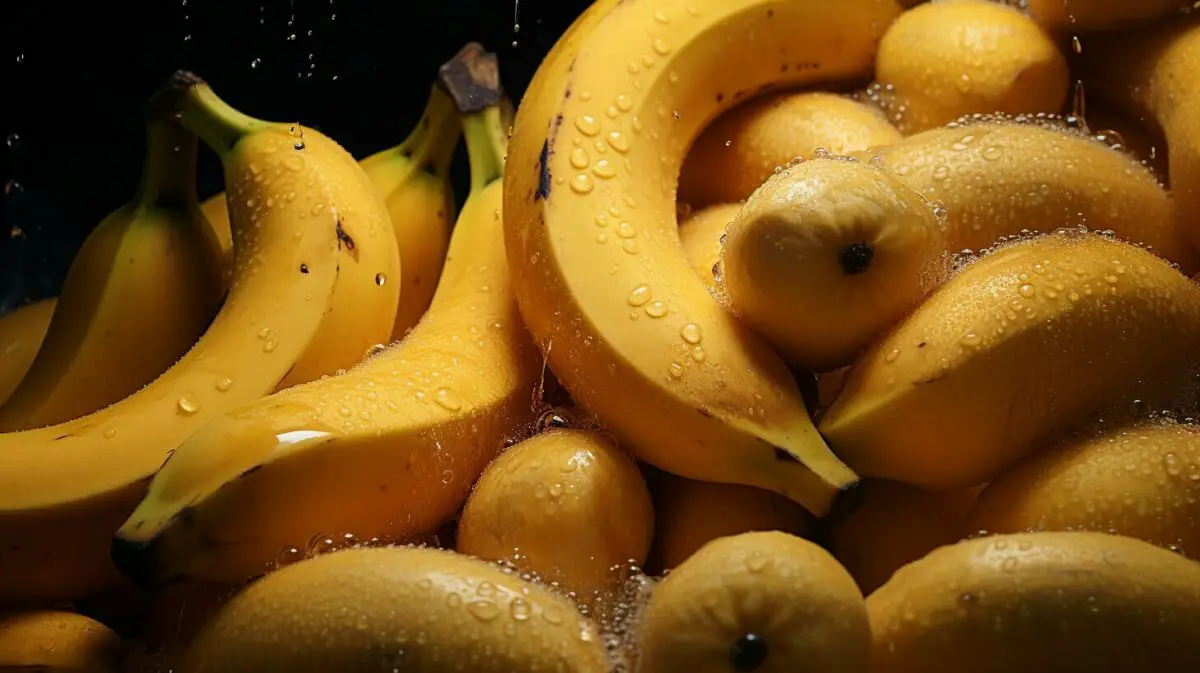
Once the bananas are thawed, they may release some liquid, which is normal. Gently stir or mash the bananas before using them in your recipes. Thawed bananas are perfect for making banana bread, smoothies, pancakes, and many other delicious treats.
Using Frozen Bananas in Recipes
Frozen bananas are a versatile ingredient that can be used in smoothies, baking, and more. They add a creamy texture and natural sweetness to a variety of dishes. Whether you have ripe bananas that need to be used or want to stock up on this versatile fruit, freezing bananas is a great way to extend their shelf life and have them on hand whenever you need them.
When it comes to using frozen bananas in recipes, there are endless possibilities. You can blend them into smoothies for a thick and frosty treat, or use them in smoothie bowls topped with your favorite fruits and toppings. Frozen bananas can also be the base for homemade ice cream or sorbet, providing a creamy and delicious alternative to traditional dairy-based desserts.
Baking with frozen bananas is another popular option. Thawed frozen bananas can be mashed and added to recipes for banana bread, muffins, pancakes, and more. Their natural sweetness and moisture make them a great substitute for some of the traditional baking ingredients like sugar and oil.
Here are some ideas for using frozen bananas in recipes:
- Create a refreshing smoothie by blending frozen bananas with other frozen berries, such as strawberries, blueberries, or raspberries. Add a splash of milk or yogurt, and you’ll have a nutritious and delicious drink.
- Make a tropical smoothie bowl by blending frozen bananas with frozen mango, pineapple, and coconut milk. Top with sliced fresh fruits, granola, and a drizzle of honey for a taste of the tropics.
- Whip up a batch of banana pancakes by adding mashed thawed bananas to your pancake batter. Serve with maple syrup and a sprinkle of cinnamon for a cozy and satisfying breakfast.
- Bake a batch of banana muffins using frozen bananas. Add some chocolate chips or nuts for extra flavor and texture.
- Create a healthier version of ice cream by blending frozen bananas with cocoa powder or peanut butter. You’ll have a creamy and indulgent treat without the guilt.
As you can see, the possibilities are endless when it comes to using frozen bananas in recipes. So, the next time you have ripe bananas or want to stock up on this versatile fruit, don’t hesitate to freeze them and start experimenting with different flavors and creations.
| Related Recipes | Ingredients | Instructions |
|---|---|---|
| Strawberry Banana Smoothie | Frozen strawberries, frozen banana, milk, honey |
|
| Banana Chocolate Chip Muffins | Frozen bananas, flour, sugar, chocolate chips, baking powder, salt, eggs, milk, vanilla extract |
|

Frozen bananas add creaminess and natural sweetness to smoothies and frozen fruit-based desserts. They are the perfect ingredient to create refreshing and nutritious treats that the whole family will love. Whether you’re looking for a quick breakfast on the go or a delicious and guilt-free dessert, these frozen fruit smoothies and popsicles are sure to satisfy your cravings.
One of my favorite recipes is a tropical paradise smoothie. In a blender, combine frozen bananas, mango chunks, pineapple chunks, and a splash of coconut milk. Blend until smooth and creamy, adding more coconut milk if needed. Pour into a glass and garnish with a slice of fresh pineapple or a sprinkle of coconut flakes.
For a fun and colorful frozen treat, try making rainbow fruit popsicles. Fill popsicle molds with layers of frozen bananas, strawberries, blueberries, kiwi, and mango. Repeat the layers until the mold is full. Insert popsicle sticks and freeze for at least 4 hours or until solid. These vibrant popsicles are not only visually appealing but also packed with vitamins and antioxidants.
Here’s a quick recipe for a refreshing smoothie bowl:
- In a blender, combine frozen bananas, frozen berries (such as blueberries and raspberries), and a splash of almond milk.
- Blend until smooth and creamy, adding more almond milk if needed.
- Pour the smoothie into a bowl and top with your favorite toppings, such as granola, sliced bananas, and a drizzle of honey.
These smoothie bowls are not only delicious but also a beautiful and Instagram-worthy way to start your day.

Whether you choose to enjoy a creamy smoothie or a refreshing popsicle, frozen bananas are a versatile and nutritious ingredient. They add a delightful sweetness and smooth texture to any frozen fruit-based recipe. So go ahead, freeze those ripe bananas, and get creative with your frozen fruit smoothies and popsicles!
| Ingredients | Instructions |
|---|---|
| Frozen bananas | 1. Slice or halve the bananas and arrange them in a single layer on a baking sheet. |
| Frozen berries (blueberries, raspberries) | 2. In a blender, combine frozen bananas, frozen berries, and a splash of almond milk. |
| Mango chunks | 3. Blend until smooth and creamy, adding more almond milk if needed. |
| Pineapple chunks | 4. Pour the smoothie into a bowl and top with your favorite toppings. |
| Coconut milk | 5. Enjoy your delicious and refreshing smoothie bowl! |
Baking with Frozen Bananas
Frozen bananas can be transformed into delicious purees, sorbets, and used as a sweetener in various baked treats. The natural sweetness and creamy texture of frozen bananas make them an excellent substitute for sugar and fats in recipes. Here are some ways to incorporate frozen bananas into your baking:
- Frozen Fruit Puree: Thawed frozen bananas can be pureed in a blender or food processor to create a smooth and creamy fruit puree. This puree can be used as a natural sweetener and moisture in cakes, muffins, and bread. Replace traditional sugar with an equal amount of banana puree for a healthier alternative.
- Frozen Fruit Sorbet: Blend frozen bananas with other frozen fruits like berries, mango, or pineapple to create a refreshing and guilt-free sorbet. Simply combine the frozen fruits in a blender until smooth and creamy. Serve immediately as a cool treat or freeze for later enjoyment.
- Frozen Fruit Ice Cream: For a dairy-free and healthier version of ice cream, blend frozen bananas with a splash of plant-based milk or coconut cream. Customize your ice cream by adding your favorite mix-ins such as nuts, chocolate chips, or coconut flakes. Transfer the mixture into a freezer-safe container and freeze until firm.
- Frozen Fruit Jam: Simmer mashed frozen bananas with a touch of lemon juice and honey to create a naturally sweet and luscious jam. Use it as a spread on toast, pancakes, or swirl it into yogurt for added flavor and sweetness.
- Frozen Fruit Compote: Cook frozen bananas with other fruits like apples, berries, or stone fruits for a delightful compote. Simply combine the fruits in a saucepan with a bit of water, sugar, and spices. Simmer until the fruits are soft and the mixture has thickened. Serve warm over pancakes, waffles, or oatmeal.
- Frozen Fruit Sauce: Blend frozen bananas with a liquid of your choice, such as coconut milk or almond milk, to create a smooth and silky fruit sauce. This sauce can be drizzled over pancakes, crepes, or desserts for an extra burst of flavor.
- Frozen Fruit Cobbler: Top a layer of frozen bananas with a buttery and crumbly topping made with oats, flour, sugar, and spices to create a comforting and delicious cobbler. Bake until the topping is golden brown and the fruit is bubbly. Serve warm with a scoop of vanilla ice cream or whipped cream.
- Frozen Fruit Crisp: Similar to cobbler, a crisp is made by layering frozen bananas with a crunchy topping made with oats, nuts, flour, sugar, and spices. Bake until the topping is crispy and the fruit is tender. Enjoy it warm with a dollop of yogurt or a drizzle of honey.
- Frozen Fruit Pie: Use thawed frozen bananas as a filling for pies. Combine mashed frozen bananas with other fruits like berries, peaches, or apples, and sweeten with a bit of sugar and spices. Pour the mixture into a pie crust and bake until golden and bubbly. Serve slices of pie with a scoop of ice cream or whipped cream.
- Frozen Fruit Cake: Add thawed frozen bananas to your favorite cake batter for a moist and flavorful cake. Whether it’s a classic banana cake, chocolate banana cake, or a fruity spice cake, the addition of frozen bananas will enhance the taste and texture of your creation.
- Frozen Fruit Cookies: Incorporate mashed frozen bananas into cookie dough to add natural sweetness and moisture. From oatmeal banana cookies to chocolate chip banana cookies, there are endless possibilities for creating delicious and healthier treats.
- Frozen Fruit Muffins: Frozen bananas can be used as a base for moist and tender muffins. Combine thawed frozen bananas with other ingredients such as flour, eggs, sugar, and spices to create flavorful muffins. Add mix-ins like nuts, dried fruits, or chocolate chips for added texture and flavor.
With these ideas, you can enjoy the versatility of frozen bananas in your baking creations. Let your imagination run wild and experiment with different flavors and combinations to create your own frozen fruit masterpieces. Remember to label and date your frozen banana creations for easy identification in your freezer.
Recommended Recipe: Banana Chocolate Chip Muffins
Try this mouthwatering recipe that combines the sweetness of frozen bananas with the richness of chocolate chips:
| Ingredients: | Instructions: |
|---|---|
|
|
Indulge in the delightful flavors of these banana chocolate chip muffins made with the goodness of frozen bananas. They are sure to please your taste buds and satisfy your cravings.
Frozen Fruit Storage Tips
Learn how to properly freeze and store various types of fruit for extended use. Freezing fruit is a great way to preserve their freshness and nutritional value while ensuring you always have a supply of your favorite fruits on hand. Whether you have an abundance of fresh fruit or want to take advantage of sales and seasonal produce, freezing is a convenient method to prevent waste and enjoy fruits year-round.
“Freezing fruit is a convenient method to prolong its shelf life and preserve its taste and texture.” – Frozen Fruit Expert
Tips for Freezing Fruit
Here are some tips to help you freeze fruit properly:
- Choose ripe or slightly underripe fruits for freezing. Overripe fruit may not freeze well and may become mushy.
- Wash the fruit thoroughly and remove any stems, leaves, or inedible parts.
- If necessary, peel and slice the fruit into desired sizes.
- For most fruits, it is recommended to blanch them before freezing to preserve their color, texture, and flavor. To blanch, briefly submerge the fruit in boiling water and then transfer to an ice bath to stop the cooking process.
- For berries and small fruits, such as cherries or grapes, freeze them in a single layer on a baking sheet before transferring them to freezer-safe bags or containers. This prevents them from sticking together.
- Label your freezer bags or containers with the name of the fruit and the date of freezing to keep track of freshness.
- Store the fruit in the freezer at 0°F (-18°C) or below for optimal results.
Freezing Fruits – Common Mistakes to Avoid
While freezing fruit is easy, here are some common mistakes to avoid:
- Freezing overripe or mushy fruit can result in a less desirable texture and flavor once thawed.
- Not blanching certain fruits may lead to a change in texture and color, especially for peaches, apricots, and apples.
- Using improper storage containers or bags that are not freezer-safe can cause freezer burn and affect the taste and quality of the fruit.
- Freezing fruits that have been previously frozen and thawed may result in a loss of texture and flavor.
- Thawing and refreezing fruit multiple times can compromise their quality and increase the risk of bacterial growth.
Frozen Fruit Storage Chart
Here’s a helpful chart to guide you in the storage times for common frozen fruits:
| Fruit | Storage Time |
|---|---|
| Blueberries | 10-12 months |
| Strawberries | 8-10 months |
| Raspberries | 10-12 months |
| Peaches | 6-8 months |
| Mango | 10-12 months |
| Pineapple | 8-10 months |
Remember to always check the quality of your frozen fruit before using it in recipes. When properly stored, frozen fruit can retain its quality and flavor for months, allowing you to enjoy the taste of summer even during the cold winter months.

Discover handy tips for freezing different types of fruit to preserve their freshness. Freezing fruit is a great way to prolong its shelf life and ensure that you always have nutritious options on hand. Whether you have an abundance of fresh fruit from your garden or want to take advantage of seasonal deals at the grocery store, freezing is a simple and convenient method to prevent spoilage and enjoy your favorite fruits all year round.
Here are some quick tips to help you freeze different types of fruit successfully:
- Choose ripe fruit: Select ripe and blemish-free fruit for freezing. Overripe fruit can become mushy when thawed.
- Wash and dry: Rinse the fruit thoroughly and pat it dry to remove any dirt or debris.
- Prepare the fruit: Remove any stems, pits, or seeds from the fruit before freezing. Peel the fruit if desired or necessary for the specific recipe.
- Flash freeze: For whole fruits like berries, spread them in a single layer on a baking sheet and freeze for a few hours. This helps prevent the fruit from clumping together and makes it easier to portion out later.
- Use proper containers: Transfer the frozen fruit to airtight, freezer-safe bags or containers. Label them with the type of fruit and the date of freezing for easy identification.
- Ensure air removal: Squeeze out any excess air from the bags or containers, as this can cause freezer burn.
- Keep a record: Maintain a freezer inventory of the fruits you have frozen, along with their freezing dates, to keep track of what needs to be used.
“Freezing fruit is not only a great way to reduce waste, but it also allows you to enjoy your favorite fruits when they are out of season. Plus, frozen fruit makes a healthy and refreshing addition to smoothies, desserts, and even savory dishes.”
Freezing Fruit Table
| Fruit | Preparation | Flash Freezing Time | Storage Time | Best Uses |
|---|---|---|---|---|
| Strawberries | Rinse, remove green tops | 2 hours | 8-12 months | Smoothies, sauces, baking |
| Blueberries | Rinse | 2 hours | 8-12 months | Pancakes, muffins, yogurt |
| Mango | Peel, cut into chunks | 3 hours | 8-12 months | Smoothies, sorbets, salsas |
| Peaches | Peel, slice | 2 hours | 8-12 months | Pies, cobblers, compotes |
| Raspberries | Rinse | 2 hours | 8-12 months | Smoothies, jams, desserts |
By following these simple tips, you can freeze a variety of fruits and have them readily available for your favorite recipes. Whether you want to add them to smoothies, bake them into pies, or simply enjoy them as a healthy snack, frozen fruit is a versatile and delicious option.

Avoid these common pitfalls to ensure the best results when freezing fruit. Whether you are freezing bananas, berries, peaches, or any other fruit, proper freezing techniques can make a big difference in preserving their flavor, texture, and nutritional value.
One common mistake is not choosing ripe or overripe fruit. Ripe fruit freezes better because it has reached its peak sweetness and flavor. On the other hand, underripe fruit may not have developed its full flavor, and overripe fruit may become mushy when frozen.
Another mistake is not properly preparing the fruit for freezing. It’s important to wash and thoroughly dry the fruit before freezing to remove any dirt or bacteria. Additionally, for fruit with pits or cores, such as peaches or apples, make sure to remove them before freezing.
Lastly, improper packaging can lead to freezer burn and loss of quality. When freezing fruit, it’s essential to use airtight, freezer-safe containers or bags that are labeled with the date. This will help maintain the freshness and prevent the fruit from absorbing any odors or flavors from the freezer.
By avoiding these common mistakes, you can enjoy the benefits of frozen fruit for a longer period. Whether you’re using frozen fruit in smoothies, baking, or simply enjoying it as a refreshing snack, proper freezing techniques will ensure that your fruit stays delicious and nutritious.

| Mistake | Explanation |
|---|---|
| Not choosing ripe fruit | Ripe fruit freezes better and retains more flavor. |
| Not properly preparing the fruit | Washing and drying fruit removes dirt and bacteria. |
| Improper packaging | Use airtight, freezer-safe containers or bags to prevent freezer burn. |
Now that you know the common mistakes to avoid, you can confidently freeze your favorite fruits and enjoy their freshness even when they’re out of season. With a little extra care and attention, frozen fruit can be a convenient and delicious addition to your diet.
How to Freeze Bananas – Conclusion
Freezing bananas and other fruits is a simple way to extend their shelf life and enjoy them in a variety of recipes. Learning how to freeze bananas properly is essential for preserving their freshness and flavor. There are three main methods for freezing bananas: freezing whole or half bananas, freezing sliced bananas, and freezing mashed bananas.
To freeze whole or half bananas, start by slicing or halving the bananas and arranging them in a single layer on a baking sheet. Freeze them for about 1 to 2 hours until they’re completely frozen, then transfer them to a labeled freezer-safe bag and store in the freezer for up to 3 months.
If you prefer sliced bananas, cut them into 1/2-inch or 1-inch rounds and arrange them on a baking sheet in a single layer. Freeze for 1 to 2 hours until solid, then transfer the slices to a freezer-safe bag and store in the freezer.
Mashed bananas can also be frozen for future use. Mash the bananas in a mixing bowl and divide the mashed bananas into equal portions in a silicone tray or muffin pan. Freeze for 2 to 3 hours, then transfer the frozen banana blocks to a labeled freezer-safe bag and store in the freezer.
When using frozen bananas in recipes, it’s best to thaw them first. Let them thaw overnight in the fridge or at room temperature for about 1 1/2 to 2 hours. Frozen bananas can be used in various delicious recipes, including smoothies, smoothie bowls, ice cream, baking, and more. They add a creamy texture and natural sweetness to your dishes, making them a convenient and versatile ingredient to have on hand.
FAQ – How to Freeze Bananas
Q: How do I freeze bananas?
A: There are three main methods for freezing bananas: freezing whole or half bananas, freezing sliced bananas, and freezing mashed bananas.
Q: How do I freeze whole or half bananas?
A: Slice or halve the bananas and arrange them in a single layer on a baking sheet. Freeze for 1 to 2 hours until completely frozen, then transfer to a freezer-safe bag labeled with the date and store in the freezer for up to 3 months.
Q: How do I freeze sliced bananas?
A: Slice the bananas into 1/2-inch or 1-inch rounds and arrange them in a single layer on a baking sheet. Freeze for 1 to 2 hours until solid, then transfer to a freezer-safe bag and store in the freezer.
Q: How do I freeze mashed bananas?
A: Mash the bananas in a mixing bowl and divide the mashed bananas into equal portions in a silicone tray or muffin pan. Freeze for 2 to 3 hours, then transfer the frozen banana blocks to a freezer-safe bag and store in the freezer.
Q: How do I thaw frozen bananas?
A: Thaw frozen bananas by letting them thaw overnight in the fridge or at room temperature for about 1 1/2 to 2 hours.
Q: What can I use frozen bananas for?
A: Frozen bananas can be used in smoothies, smoothie bowls, ice cream, baking, and more. They’re a convenient ingredient to have on hand for various recipes.
Our Friends
- https://www.eatingbirdfood.com/how-to-freeze-bananas/
- https://fitfoodiefinds.com/how-to-freeze-bananas/
Related Recipes:
 How to Store Bananas for Extended Ripeness
How to Store Bananas for Extended Ripeness
 Identifying Ripe Bananas: A Quick Guide
Identifying Ripe Bananas: A Quick Guide
 How to Freeze Passion Fruit? (Step-By-Step Guide)
How to Freeze Passion Fruit? (Step-By-Step Guide)
 How to Freeze Avocados? (Perfect Step-By-Step Guide)
How to Freeze Avocados? (Perfect Step-By-Step Guide)
 How to Cut Dragon Fruit? (Perfect Step-By-Step Guide)
How to Cut Dragon Fruit? (Perfect Step-By-Step Guide)
 Picking the Perfect Dragon Fruit: Ripe Signs
Picking the Perfect Dragon Fruit: Ripe Signs
 Picking Ripe Passion Fruit: A Guide
Picking Ripe Passion Fruit: A Guide
 How to Freeze Oranges: Keep Citrus Fresh for Longer
How to Freeze Oranges: Keep Citrus Fresh for Longer


